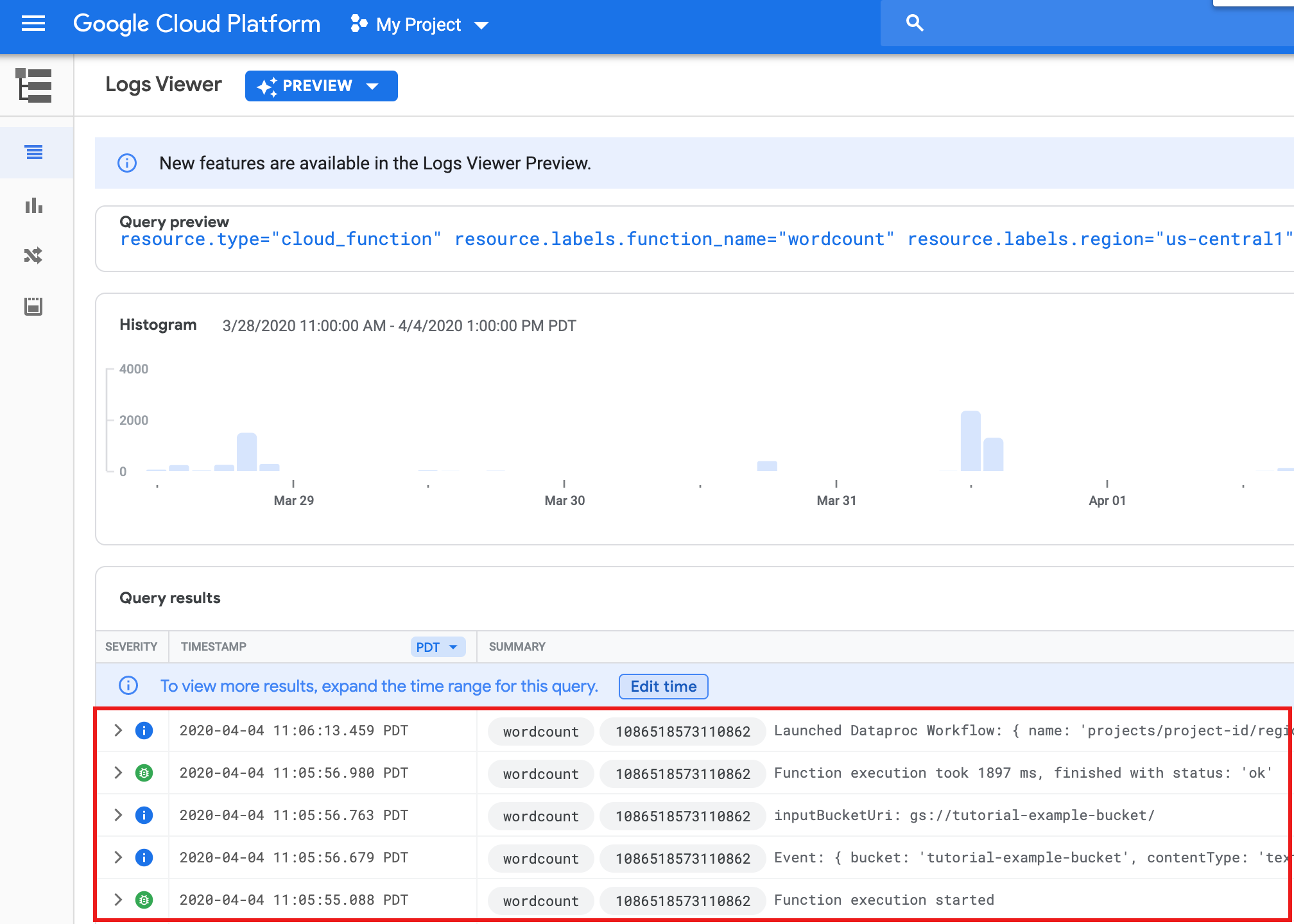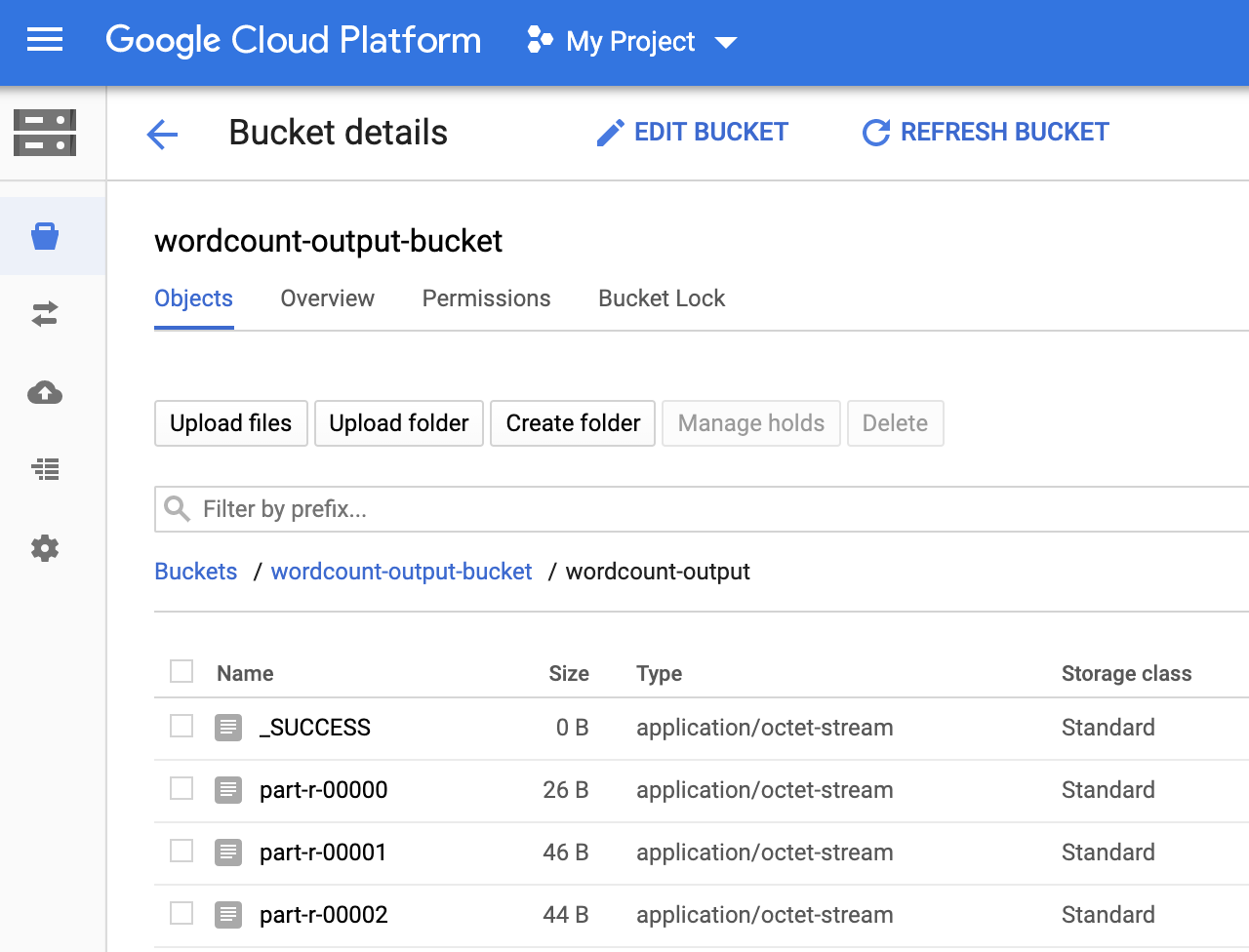시작하기 전에
아직 설정하지 않은 경우 Google Cloud 프로젝트와 Cloud Storage 버킷 두 개(2)를 설정합니다.
프로젝트 설정
- Sign in to your Google Cloud account. If you're new to Google Cloud, create an account to evaluate how our products perform in real-world scenarios. New customers also get $300 in free credits to run, test, and deploy workloads.
-
In the Google Cloud console, on the project selector page, select or create a Google Cloud project.
Roles required to select or create a project
- Select a project: Selecting a project doesn't require a specific IAM role—you can select any project that you've been granted a role on.
-
Create a project: To create a project, you need the Project Creator
(
roles/resourcemanager.projectCreator), which contains theresourcemanager.projects.createpermission. Learn how to grant roles.
-
Verify that billing is enabled for your Google Cloud project.
-
Enable the Dataproc, Compute Engine, Cloud Storage, and Cloud Run functions APIs.
Roles required to enable APIs
To enable APIs, you need the Service Usage Admin IAM role (
roles/serviceusage.serviceUsageAdmin), which contains theserviceusage.services.enablepermission. Learn how to grant roles. -
Install the Google Cloud CLI.
-
외부 ID 공급업체(IdP)를 사용하는 경우 먼저 제휴 ID로 gcloud CLI에 로그인해야 합니다.
-
gcloud CLI를 초기화하려면, 다음 명령어를 실행합니다.
gcloud init -
In the Google Cloud console, on the project selector page, select or create a Google Cloud project.
Roles required to select or create a project
- Select a project: Selecting a project doesn't require a specific IAM role—you can select any project that you've been granted a role on.
-
Create a project: To create a project, you need the Project Creator
(
roles/resourcemanager.projectCreator), which contains theresourcemanager.projects.createpermission. Learn how to grant roles.
-
Verify that billing is enabled for your Google Cloud project.
-
Enable the Dataproc, Compute Engine, Cloud Storage, and Cloud Run functions APIs.
Roles required to enable APIs
To enable APIs, you need the Service Usage Admin IAM role (
roles/serviceusage.serviceUsageAdmin), which contains theserviceusage.services.enablepermission. Learn how to grant roles. -
Install the Google Cloud CLI.
-
외부 ID 공급업체(IdP)를 사용하는 경우 먼저 제휴 ID로 gcloud CLI에 로그인해야 합니다.
-
gcloud CLI를 초기화하려면, 다음 명령어를 실행합니다.
gcloud init - In the Google Cloud console, go to the Cloud Storage Buckets page.
- Click Create.
- On the Create a bucket page, enter your bucket information. To go to the next
step, click Continue.
-
In the Get started section, do the following:
- Enter a globally unique name that meets the bucket naming requirements.
- To add a
bucket label,
expand the Labels section (),
click add_box
Add label, and specify a
keyand avaluefor your label.
-
In the Choose where to store your data section, do the following:
- Select a Location type.
- Choose a location where your bucket's data is permanently stored from the Location type drop-down menu.
- If you select the dual-region location type, you can also choose to enable turbo replication by using the relevant checkbox.
- To set up cross-bucket replication, select
Add cross-bucket replication via Storage Transfer Service and
follow these steps:
Set up cross-bucket replication
- In the Bucket menu, select a bucket.
In the Replication settings section, click Configure to configure settings for the replication job.
The Configure cross-bucket replication pane appears.
- To filter objects to replicate by object name prefix, enter a prefix that you want to include or exclude objects from, then click Add a prefix.
- To set a storage class for the replicated objects, select a storage class from the Storage class menu. If you skip this step, the replicated objects will use the destination bucket's storage class by default.
- Click Done.
-
In the Choose how to store your data section, do the following:
- Select a default storage class for the bucket or Autoclass for automatic storage class management of your bucket's data.
- To enable hierarchical namespace, in the Optimize storage for data-intensive workloads section, select Enable hierarchical namespace on this bucket.
- In the Choose how to control access to objects section, select whether or not your bucket enforces public access prevention, and select an access control method for your bucket's objects.
-
In the Choose how to protect object data section, do the
following:
- Select any of the options under Data protection that you
want to set for your bucket.
- To enable soft delete, click the Soft delete policy (For data recovery) checkbox, and specify the number of days you want to retain objects after deletion.
- To set Object Versioning, click the Object versioning (For version control) checkbox, and specify the maximum number of versions per object and the number of days after which the noncurrent versions expire.
- To enable the retention policy on objects and buckets, click the Retention (For compliance) checkbox, and then do the following:
- To enable Object Retention Lock, click the Enable object retention checkbox.
- To enable Bucket Lock, click the Set bucket retention policy checkbox, and choose a unit of time and a length of time for your retention period.
- To choose how your object data will be encrypted, expand the Data encryption section (), and select a Data encryption method.
- Select any of the options under Data protection that you
want to set for your bucket.
-
In the Get started section, do the following:
- Click Create.
- 워크플로 템플릿 만들기
gcloud dataproc workflow-templates create wordcount-template \ --region=us-central1
- 워크플로 템플릿에 workflow 작업을 추가합니다.
-
명령어를 실행하기 전에 output-bucket-name를 지정합니다(함수가 입력 버킷을 제공함).
출력 버킷 이름을 삽입한 후 출력 버킷 인수는 다음과 같이 표시됩니다.
gs://your-output-bucket/wordcount-output" -
'count' 단계 ID는 필수이며 추가된 hadoop 작업을 식별합니다.
gcloud dataproc workflow-templates add-job hadoop \ --workflow-template=wordcount-template \ --step-id=count \ --jar=file:///usr/lib/hadoop-mapreduce/hadoop-mapreduce-examples.jar \ --region=us-central1 \ -- wordcount gs://input-bucket gs://output-bucket-name/wordcount-output
-
명령어를 실행하기 전에 output-bucket-name를 지정합니다(함수가 입력 버킷을 제공함).
출력 버킷 이름을 삽입한 후 출력 버킷 인수는 다음과 같이 표시됩니다.
- 관리형, 단일 노드 클러스터를 사용하여 워크플로를 실행합니다. Dataproc이 클러스터를 만들고 워크플로를 실행한 다음 워크플로가 완료되면 클러스터를 삭제합니다.
gcloud dataproc workflow-templates set-managed-cluster wordcount-template \ --cluster-name=wordcount \ --single-node \ --region=us-central1 - Google Cloud 콘솔의 Dataproc 워크플로 페이지에서
wordcount-template이름을 클릭하여 워크플로 템플릿 세부정보 페이지를 엽니다. wordcount-template 속성을 확인합니다.
- 매개변수화를 위해 워크플로 템플릿을
wordcount.yaml텍스트 파일로 내보냅니다.gcloud dataproc workflow-templates export wordcount-template \ --destination=wordcount.yaml \ --region=us-central1
- 텍스트 편집기를 사용하여
wordcount.yaml를 연 다음 YAML 파일 끝에parameters블록을 추가하여 워크플로가 트리거될 때 Cloud Storage INPUT_BUCKET_URI를 wordcount 바이너리에args[1]로 전달할 수 있습니다.다음은 내보낸 YAML 파일의 예입니다. 두 가지 방법 중 하나를 사용하여 템플릿을 업데이트할 수 있습니다.
- your-output_bucket를 출력 버킷 이름으로 바꾼 후 내보낸
wordcount.yaml를 바꾸려면 전체 파일을 복사하여 붙여넣습니다. 또는 - 내보낸
wordcount.yaml파일의 끝에parameters섹션만 복사하여 붙여넣습니다.
jobs: - hadoopJob: args: - wordcount - gs://input-bucket - gs://your-output-bucket/wordcount-output mainJarFileUri: file:///usr/lib/hadoop-mapreduce/hadoop-mapreduce-examples.jar stepId: count placement: managedCluster: clusterName: wordcount config: softwareConfig: properties: dataproc:dataproc.allow.zero.workers: 'true' parameters: - name: INPUT_BUCKET_URI description: wordcount input bucket URI fields: - jobs['count'].hadoopJob.args[1] - your-output_bucket를 출력 버킷 이름으로 바꾼 후 내보낸
- 매개변수화된
wordcount.yaml텍스트 파일을 가져옵니다. 템플릿을 덮어쓸지 묻는 메시지가 표시되면 'Y'를 입력합니다.gcloud dataproc workflow-templates import wordcount-template \ --source=wordcount.yaml \ --region=us-central1
Google Cloud 콘솔에서 Cloud Run Functions 페이지를 연 다음 함수 만들기를 클릭합니다.
함수 만들기 페이지에서 다음 정보를 입력하거나 선택합니다.
- 이름: wordcount
- 메모리 할당: 기본 선택을 유지합니다.
- 트리거:
- Cloud Storage
- 이벤트 유형: 확정/만들기
- 버킷: 입력 버킷을 선택합니다(프로젝트에서 Cloud Storage 버킷 만들기 참조). 이 버킷에 파일이 추가되면 함수가 워크플로를 트리거합니다. 워크플로는 버킷의 모든 텍스트 파일을 처리하는 Wordcount 애플리케이션을 실행합니다.
소스 코드:
- 인라인 편집기
- 런타임: Node.js
INDEX.JS탭: 기본 코드 스니펫을 다음 코드로 바꾼 다음const projectId줄을 수정하여 -your-project-id-(앞 또는 뒤에 '-'없이)를 입력합니다.
const dataproc = require('@google-cloud/dataproc').v1; exports.startWorkflow = (data) => { const projectId = '-your-project-id-' const region = 'us-central1' const workflowTemplate = 'wordcount-template' const client = new dataproc.WorkflowTemplateServiceClient({ apiEndpoint: `${region}-dataproc.googleapis.com`, }); const file = data; console.log("Event: ", file); const inputBucketUri = `gs://${file.bucket}/${file.name}`; const request = { name: client.projectRegionWorkflowTemplatePath(projectId, region, workflowTemplate), parameters: {"INPUT_BUCKET_URI": inputBucketUri} }; client.instantiateWorkflowTemplate(request) .then(responses => { console.log("Launched Dataproc Workflow:", responses[1]); }) .catch(err => { console.error(err); }); };PACKAGE.JSON탭: 기본 코드 스니펫을 다음 코드로 바꿉니다.
{ "name": "dataproc-workflow", "version": "1.0.0", "dependencies":{ "@google-cloud/dataproc": ">=1.0.0"} }- 실행할 함수: 'startWorkflow'를 삽입합니다.
만들기를 클릭합니다.
공개 파일
rose.txt을 버킷에 복사하여 함수를 트리거합니다. 명령어에 your-input-bucket-name(함수를 트리거하는 데 사용되는 버킷)을 삽입합니다.gcloud storage cp gs://pub/shakespeare/rose.txt gs://your-input-bucket-name
30초 동안 기다린 후 다음 명령어를 실행하여 함수가 성공적으로 완료되었는지 확인합니다.
gcloud functions logs read wordcount
... Function execution took 1348 ms, finished with status: 'ok'
Google Cloud 콘솔의 함수 목록 페이지에서 함수 로그를 보려면
wordcount함수 이름을 클릭한 다음 함수 세부정보 페이지에서 로그 보기를 클릭합니다.
Google Cloud 콘솔의 스토리지 브라우저 페이지에서 출력 버킷의
wordcount-output폴더를 볼 수 있습니다.
워크플로가 완료되면 작업 세부정보가Google Cloud 콘솔에 유지됩니다. Dataproc 작업 페이지에 나열된
count...작업을 클릭하여 워크플로 작업 세부정보를 확인합니다.
- In the Google Cloud console, go to the Manage resources page.
- In the project list, select the project that you want to delete, and then click Delete.
- In the dialog, type the project ID, and then click Shut down to delete the project.
- In the Google Cloud console, go to the Cloud Storage Buckets page.
- Click the checkbox for the bucket that you want to delete.
- To delete the bucket, click Delete, and then follow the instructions.
- Dataproc 워크플로 템플릿 개요 참조하기
- 워크플로 예약 솔루션 참조하기
프로젝트에서 2개의 Cloud Storage 버킷 만들기 또는 사용하기
프로젝트에는 Cloud Storage 버킷 두 개가 필요합니다. 하나는 입력 파일용, 다른 하나는 출력 파일용입니다.
워크플로 템플릿 만들기
워크플로 템플릿을 만들고 정의하려면 로컬 터미널 창 또는 Cloud Shell에서 다음 명령어를 복사하고 실행합니다.
워크플로 템플릿 매개변수화
워크플로 템플릿에 전달할 입력 버킷 변수를 매개변수화합니다.
Cloud 함수 만들기
함수 테스트
삭제
이 튜토리얼의 워크플로는 워크플로가 완료되면 관리 클러스터를 삭제합니다. 반복되는 비용이 발생하지 않도록 이 튜토리얼과 관련된 다른 리소스를 삭제할 수 있습니다.
프로젝트 삭제
Cloud Storage 버킷 삭제
워크플로 템플릿 삭제
gcloud dataproc workflow-templates delete wordcount-template \ --region=us-central1
Cloud 함수 삭제
Google Cloud 콘솔에서 Cloud Run Functions 페이지를 열고 wordcount 함수 왼쪽에 있는 체크박스를 선택한 다음 삭제를 클릭합니다.

